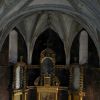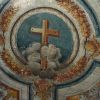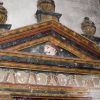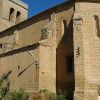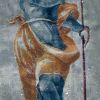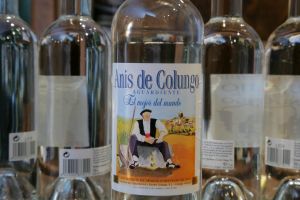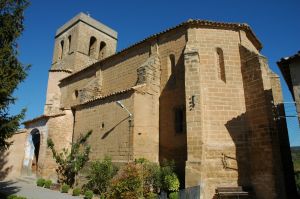The church of Nuestra Señora del Pilar (Our Lady of the Pillar) has a single nave in two sections and the east end is polygonal in shape, which can be appreciated from both the interior and exterior of the building. The chapels are relatively low and are reached from the second section of the nave.
A solid tower, made entirely from stone, is attached to the west end of the church and the belfry is beautifully finished with capital and parapet.
The church was built from ashlars, square blocks of sandstone, which are full of markings left by the various stone masons that worked here. The buttresses reach the height of the eaves and appear as small Doric pilasters supporting a stone cornice that runs around the perimeter of the building. The two pilasters of the south-facing wall are decorated with mouldings and feature a group of inscriptions that make reference to the master builders responsible for the construction of the church; “IVAN TORON ME FECIT” (made by Torón) and …DE IVAN TELLET (made by Tellet).
The classically inspired doorway is set in the first section of the nave. The semicircular arch (segmental on the inside) is supported by pilasters on podiums whose fronts are decorated with a relief of cherubs. This is faded and hard to make out in parts due to the erosion of the sandstone. Inside the door jamb the decoration is finished off with cornucopia and birds. The intrados of the arch features coffers decorated with floral motifs and the spandrels above have ornamental consoles and mirrors. There two Corinthian columns flanking the doorway have fluted shafts and originally supported a pediment and frieze. These elements were hidden when years after the doorway was built, the church porch was renovated.
The west end of the church houses the choir with a delightful parapet of carved wood, which is covered with a rib vault. The vaults are simple in design with severies and ribs are made out of stone. The ribs are finely sculpted and are grouped together in clusters which drop down onto decorated cantilevers, also chiselled from stone. All keystones are carved with vegetal decoration with the exception of the keystone in the vestry, which has an inscription relating to Christ: IHS:
The chapels face each other and are accessed through semicircular arches with convex moulding. They are covered with simple rib vaults with the ribs dropping gracefully onto slender cantilevers.At the west end of the church there is a further chapel with a barrel vault, lit by an arched opening, which is in fact the base of the tower. Although it was originally used for baptisms, today it is dedicated to Santo Cristo. In the 18th century the walls and ceiling were decorated with images that represented the twelve apostles.
Although there are no direct documented references to the architect responsible for the construction of the church, markings on the exterior walls credit the work to Joan Torón, a well known church builder. He often worked alongside Antón Torón and Martin Torón and together they designed some of the finest buildings to be erected in Somontano during the 16th century; buildings in Azlor, Naval (1609), Abiego (1584) and Colungo and the Lunel chapel in the cathedral of Barbastro (1609). Other projects outside of Somontano include the splendid parish church of Olsón in Sobrarbe.
Another 16th century Aragonese constructor is also credited in stone; Joan Tellet. He was known as the “stone cutter” or the “master stone mason.” He was a true Renaissance architect and, being well informed of designs and constructions in other places, was able to put this knowledge to good use in the churches he built in Somontano. In 1546 he joined up with Torón in the construction of the Santa Bárbara church in Olsón. One inscription he made on the door of the vestry reads JOAN TELLET ME FECIT 1546.
In 1566 Joan Tellet signed a contract to finish work on the church of Virgen de la Peña in Graus and to repair the Santa Bárbara bridge in the same vicinity. He also oversaw the construction of the church in Castejón de Sobrarbe, where he left an inscription reading JOAN TELLET ME YZO 1557. In 1562 he was commissioned to build a bridge over the River Alcanadre. Joan de Segura, one of the best local builders at the time, is also noted on the contract as guarantor.
In 1566 he was responsible for constructing the church of Gil and a few years late in 1570, took part in the construction of the retaining walls of Biescas. In addition to the recorded projects he worked on, he must have carried out others in Monzón and Sariñena, villages where he was listed as living in other documentation. In 1572 it is known that he lived in Barbuñales as his name appears on the contract for the widening of the bridge; however he died shortly after, in the year 1575.
The majority of the constructions that these master builders oversaw are characterised by their sheer size and for their excellent stone work. The different quality of the local quarries from which the ashlars were extracted dictated the development of certain quarries and marked the state of the industry in our current day.
The finishing of the church in Colungo before 1575 as well as the quality of the work must have caused a great impact on neighbouring villages; indeed in the agreement to build the church in Salas Altas, it was mentioned as a model to be followed. It can be deduced therefore that the Salas Altas Council were highly impressed with the church in Colungo, but the style and grandeur that Joan Torón and Joan Tellet afforded their building was not achieved in their village.
The church in Colungo is currently in a deteriorated state:
There is a lack of light inside due to renovations that blocked the windows, the sandstone has been worn away by the erosive effects of the weather and there is a general sorry state of abandonment. However these impressions should not take away from the superior workmanship of the distinguished master builders, Torón and Tellet.



